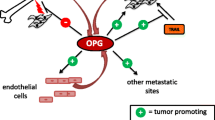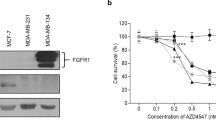Abstract
Osteopontin (OPN) has been clinically and experimentally associated with breast cancer metastasis. Proteolytic cleavage of OPN by thrombin has been reported to increase its biologic activity. The purpose of this study was to determine if inhibition of thrombin could reduce the malignancy-promoting effects of OPN on breast cancer cell behavior in vitro and in vivo. MDA-MB-468 human breast cancer cells were stably transfected to overexpress OPN (468-OPN) or a control vector (468-CON) and compared for functional differences in malignant/metastatic behavior in response to treatment with the thrombin-specific inhibitor Argatroban. Western blot analysis revealed that both 468-CON and 468-OPN cells produce thrombin and the thrombin-related protein tissue factor, and express very low levels of thrombin receptor (PAR-1). In vitro assays demonstrated that Argatroban treatment (25 μg/ml) of 468-OPN cells resulted in decreased cell growth, colony-forming ability, adhesion, and migration relative to untreated controls (P < 0.05), but did not have a significant effect on 468-CON cells. Following mammary fat pad injection, treatment with Argatroban (9 mg/kg/day) increased the in vivo tumor latency of both 468-CON and 468-OPN cells, and reduced primary tumor growth of 468-OPN cells (relative to untreated controls; P < 0.05). Furthermore, Argatroban treatment significantly decreased lymphatic metastasis of both 468-CON (P < 0.04) and 468-OPN (P < 0.01) cells relative to untreated controls. These novel findings indicate that inhibition of thrombin can reduce malignant and metastatic behavior of MDA-MB-468 breast cancer cells using both OPN-dependent and OPN-independent mechanisms, and suggest that thrombin inhibitors such as Argatroban may hold potential as therapeutic agents to combat breast cancer progression.





Similar content being viewed by others
Abbreviations
- ANOVA:
-
Analysis of variance
- BSA:
-
Bovine serum albumin
- EDTA:
-
Ethylenediaminetetraacetic acid
- EGFR:
-
Epidermal growth factor receptor
- FBS:
-
Fetal bovine serum
- FITC:
-
Fluorescein isothiocyanate
- H&E:
-
Hematoxylin and eosin
- HGF:
-
Hepatocyte growth factor
- HPF:
-
High-powered field
- HRP:
-
Horseradish peroxidase
- LN:
-
Lymph node
- LMWH:
-
Low molecular weight heparin
- LVI:
-
Lymphovascular invasion
- MEM:
-
Minimum essential media
- OPN:
-
Osteopontin
- PAR:
-
Protease-activated receptor
- PE:
-
Phycoerythrin
- PBS:
-
Phosphate-buffered saline
- PMSF:
-
Phenylmethylsulfonyl fluoride
- RGB:
-
Red green blue
- RGD:
-
Arginine–Glycine–Aspartate
- SDS:
-
Sodium dodecyl sulfate
- TBST:
-
Tris-buffered saline + 0.05% Tween-20
- TF:
-
Tissue factor
- TGF-α:
-
Transforming growth factor α
- VN:
-
Vitronectin
References
Jemal A, Siegel R, Ward E et al (2007) Cancer statistics, 2007. CA Cancer J Clin 57:43–66
Chambers AF, Groom AC, MacDonald IC (2002) Dissemination and growth of cancer cells in metastatic sites. Nat Rev Cancer 2:563–572
Nierodzik ML, Karpatkin S (2006) Thrombin induces tumor growth, metastasis, and angiogenesis: evidence for a thrombin-regulated dormant tumor phenotype. Cancer Cell 10:355–362
Nierodzik ML, Plotkin A, Kajumo F et al (1991) Thrombin stimulates tumor-platelet adhesion in vitro and metastasis in vivo. J Clin Invest 87:229–236
Rickles FR, Patierno S, Fernandez PM (2003) Tissue factor, thrombin, and cancer. Chest 124:58S–68S
Tsopanoglou NE, Pipili-Synetos E, Maragoudakis ME (1993) Thrombin promotes angiogenesis by a mechanism independent of fibrin formation. Am J Physiol 264:C1302–C1307
Wojtukiewicz MZ, Tang DG, Ciarelli JJ et al (1993) Thrombin increases the metastatic potential of tumor cells. Int J Cancer 54:793–806
Di Nisio M, Middeldorp S, Buller HR (2005) Direct thrombin inhibitors. N Engl J Med 353:1028–1040
Fareed J, Jeske WP (2004) Small-molecule direct antithrombins: Argatroban. Best Pract Res Clin Haematol 17:127–138
Asanuma K, Wakabayashi H, Hayashi T et al (2004) Thrombin inhibitor, Argatroban, prevents tumor cell migration and bone metastasis. Oncology 67:166–173
Hua Y, Tang LL, Fewel ME et al (2005) Systemic use of Argatroban reduces tumor mass, attenuates neurological deficits and prolongs survival time in rat glioma models. Acta Neurochir Suppl 95:403–406
Kurata M, Okajima K, Kawamoto T et al (2006) Antithrombin reduces reperfusion-induced hepatic metastasis of colon cancer cells. World J Gastroenterol 12:60–65
Bereczky B, Gilly R, Raso E et al (2005) Selective antimetastatic effect of heparins in preclinical human melanoma models is based on inhibition of migration and microvascular arrest. Clin Exp Metastasis 22:69–76
Esumi N, Fan D, Fidler IJ (1991) Inhibition of murine melanoma experimental metastasis by recombinant desulfatohirudin, a highly specific thrombin inhibitor. Cancer Res 51:4549–4556
Coughlin SR (2000) Thrombin signalling and protease-activated receptors. Nature 407:258–264
Even-Ram S, Uziely B, Cohen P et al (1998) Thrombin receptor overexpression in malignant and physiological invasion processes. Nat Med 4:909–914
Ossovskaya VS, Bunnett NW (2004) Protease-activated receptors: contribution to physiology and disease. Physiol Rev 84:579–621
Furger KA, Menon RK, Tuck AB et al (2001) The functional and clinical roles of osteopontin in cancer and metastasis. Curr Mol Med 1:621–632
Rittling SR, Chambers AF (2004) Role of osteopontin in tumour progression. Br J Cancer 90:1877–1881
Wai PY, Kuo PC (2004) The role of osteopontin in tumor metastasis. J Surg Res 121:228–241
Bramwell VH, Doig GS, Tuck AB et al (2006) Serial plasma osteopontin levels have prognostic value in metastatic breast cancer. Clin Cancer Res 12:3337–3343
Rudland PS, Platt-Higgins A, El-Tanani M et al (2002) Prognostic significance of the metastasis-associated protein osteopontin in human breast cancer. Cancer Res 62:3417–3427
Singhal H, Bautista DS, Tonkin KS et al (1997) Elevated plasma osteopontin in metastatic breast cancer associated with increased tumor burden and decreased survival. Clin Cancer Res 3:605–611
Adwan H, Bauerle T, Najajreh Y et al (2004) Decreased levels of osteopontin and bone sialoprotein II are correlated with reduced proliferation, colony formation, and migration of GFP-MDA-MB-231 cells. Int J Oncol 24:1235–1244
Mi Z, Oliver T, Guo H et al (2007) Thrombin-cleaved COOH(-) terminal osteopontin peptide binds with cyclophilin C to CD147 in murine breast cancer cells. Cancer Res 67:4088–4097
Allan AL, George R, Vantyghem SA et al (2006) Role of the integrin-binding protein osteopontin in lymphatic metastasis of breast cancer. Am J Pathol 169:233–246
Cook AC, Chambers AF, Turley EA et al (2006) Osteopontin induction of hyaluronan synthase 2 expression promotes breast cancer malignancy. J Biol Chem 281:24381–24389
Furger KA, Allan AL, Wilson SM et al (2003) Beta(3) integrin expression increases breast carcinoma cell responsiveness to the malignancy-enhancing effects of osteopontin. Mol Cancer Res 1:810–819
Khan SA, Cook AC, Kappil M et al (2005) Enhanced cell surface CD44 variant (v6, v9) expression by osteopontin in breast cancer epithelial cells facilitates tumor cell migration: novel post-transcriptional, post-translational regulation. Clin Exp Metastasis 22:663–673
Tuck AB, Elliott BE, Hota C et al (2000) Osteopontin-induced, integrin-dependent migration of human mammary epithelial cells involves activation of the hepatocyte growth factor receptor (Met). J Cell Biochem 78:465–475
Tuck AB, Hota C, Chambers AF (2001) Osteopontin(OPN)-induced increase in human mammary epithelial cell invasiveness is urokinase (uPA)-dependent. Breast Cancer Res Treat 70:197–204
Tuck AB, Hota C, Wilson SM et al (2003) Osteopontin-induced migration of human mammary epithelial cells involves activation of EGF receptor and multiple signal transduction pathways. Oncogene 22:1198–1205
Sodek J, Ganss B, McKee MD (2000) Osteopontin. Crit Rev Oral Biol Med 11:279–303
Kon S, Yokosaki Y, Maeda M et al (2002) Mapping of functional epitopes of osteopontin by monoclonal antibodies raised against defined internal sequences. J Cell Biochem 84:420–432
Yokosaki Y, Matsuura N, Sasaki T et al (1999) The integrin alpha(9)beta(1) binds to a novel recognition sequence (SVVYGLR) in the thrombin-cleaved amino-terminal fragment of osteopontin. J Biol Chem 274:36328–36334
Senger DR, Perruzzi CA (1996) Cell migration promoted by a potent GRGDS-containing thrombin-cleavage fragment of osteopontin. Biochim Biophys Acta 1314:13–24
Senger DR, Perruzzi CA, Papadopoulos-Sergiou A et al (1994) Adhesive properties of osteopontin: regulation by a naturally occurring thrombin-cleavage in close proximity to the GRGDS cell-binding domain. Mol Biol Cell 5:565–574
Smith LL, Giachelli CM (1998) Structural requirements for alpha 9 beta 1-mediated adhesion and migration to thrombin-cleaved osteopontin. Exp Cell Res 242:351–360
Price JE, Polyzos A, Zhang RD et al (1990) Tumorigenicity and metastasis of human breast carcinoma cell lines in nude mice. Cancer Res 50:717–721
Tuck AB, Arsenault DM, O’Malley FP et al (1999) Osteopontin induces increased invasiveness and plasminogen activator expression of human mammary epithelial cells. Oncogene 18:4237–4246
Young MF, Kerr JM, Termine JD et al (1990) cDNA cloning, mRNA distribution and heterogeneity, chromosomal location, and RFLP analysis of human osteopontin (OPN). Genomics 7:491–502
Bautista DS, Xuan JW, Hota C et al (1994) Inhibition of Arg-Gly-Asp (RGD)-mediated cell adhesion to osteopontin by a monoclonal antibody against osteopontin. J Biol Chem 269:23280–23285
Cameron MD, Schmidt EE, Kerkvliet N, Nadkarni KV, Morris VL, Groom AC, Chambers AF, MacDonald IC. (2000) Temporal progression of metastasis in lung: cell survival, dormancy, and location dependence of metastatic inefficiency. Cancer Res 60:2541–2546
Jain S, Chakraborty G, Bulbule A et al (2007) Osteopontin: an emerging therapeutic target for anticancer therapy. Exp Opin Ther Targets 11:81–90
Matsuno H, Kozawa O, Okada K et al (2002) Inhibitors of fibrinolytic components play different roles in the formation and removal of arterial thrombus in mice. J Cardiovasc Pharmacol 39:278–286
Falanga A, Zacharski L (2005) Deep vein thrombosis in cancer: the scale of the problem and approaches to management. Ann Oncol 16:696–701
Goyal D, Choudhury A, Lip GY (2005) Thrombotic complications and thromboprophylaxis in breast and gynaecological malignancies. Curr Opin Obstet Gynecol 17:13–20
Kakkar AK, Levine MN, Kadziola Z et al (2004) Low molecular weight heparin, therapy with dalteparin, and survival in advanced cancer: the fragmin advanced malignancy outcome study (FAMOUS). J Clin Oncol 22:1944–1948
Klerk CP, Smorenburg SM, Otten HM et al (2005) The effect of low molecular weight heparin on survival in patients with advanced malignancy. J Clin Oncol 23:2130–2135
Lee AY, Rickles FR, Julian JA et al (2005) Randomized comparison of low molecular weight heparin and coumarin derivatives on the survival of patients with cancer and venous thromboembolism. J Clin Oncol 23:2123–2129
Acknowledgements
We thank Michael Keeney and the London Health Sciences Centre Flow Cytometry Unit for their help in carrying out and analyzing the flow cytometry studies. We also thank Michael Keeney, Ian Chin-Yee, and Anargyros Xenocostas for helpful discussions and intellectual input. This work was supported in part by grants from the London Regional Cancer Program and the National Research Council of Canada (to A.L.A.) and by grant #04-MAY-00089 from the Ontario Cancer Research Network (to A.F.C. and A.B.T.). B.D.H. is the recipient of a Translational Breast Cancer Scholarship through the London Regional Cancer Program. A.F.C. is the recipient of a Canada Research Chair in Oncology. A.L.A. is supported by the Imperial Oil Foundation.
Author information
Authors and Affiliations
Corresponding author
Rights and permissions
About this article
Cite this article
Schulze, E.B., Hedley, B.D., Goodale, D. et al. The thrombin inhibitor Argatroban reduces breast cancer malignancy and metastasis via osteopontin-dependent and osteopontin-independent mechanisms. Breast Cancer Res Treat 112, 243–254 (2008). https://doi.org/10.1007/s10549-007-9865-4
Received:
Accepted:
Published:
Issue Date:
DOI: https://doi.org/10.1007/s10549-007-9865-4




